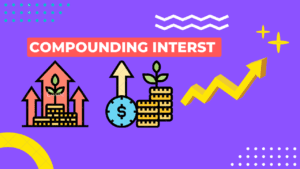Introduction:
Investing is important in personal finance because it lets people build wealth and reach their financial goals. It involves investing money in a variety of assets with the intention of receiving income or returns over a period of time. While managing investing money comes with risks, it also has the potential for long-term financial growth and stability. The fundamentals of investing, such as the power of compound interest, the various investment options, and the relationship between risk and return, will be discussed in this section. Individuals can confidently begin their investment journey and make well-informed decisions by comprehending these essential concepts.
The Power of Compound Interest .


Due to its remarkable capacity to increase wealth exponentially over time, compound interest is frequently referred to as the “eighth wonder of the world.” It is the process of earning interest on both the initial investment and the interest that has accumulated over time. This intensifying impact can altogether upgrade speculation returns, particularly throughout lengthy time skylines.
Let’s take a look at an example to see how powerful compound interest is:
Let’s say a person invests $10,000 with an annual return of 8%. They would earn $800 in interest in the first year. They reinvest the interest in addition to the initial amount rather than withdrawing it. They would earn $864 in interest in the second year at 8% on $10,800. The compounding effect continues to snowball over time, resulting in significant returns.
The earlier an individual starts investing, the additional time their speculations need to profit from the force of compounding. Individuals can realize the full potential of compound interest by making regular contributions and allowing their investments to grow over time.
Types of Investments


There are a number of choices for investments, each of which has its own characteristics and potential returns. Common types of investments include:
Stocks:
Stocks are ownership stakes in a business. When a person makes an investment in stocks, they become shareholders and stand to gain from the expansion and profitability of the business. Stocks can give both capital appreciation and profit pay. Be that as it may, stock costs can be unstable and affected by different factors, for example, economic situations, organization execution, and financial patterns.
Bonds:
In order to raise funds, bonds are debt instruments issued by governments, municipalities, or businesses. When a person buys bonds, they are essentially lending the issuer money in exchange for periodic interest payments and the return of the principal at maturity. When compared to stocks, bonds are generally regarded as investments with lower risk. The issuer’s creditworthiness and the current interest rate are largely responsible for bond risk. Bonds, particularly those issued by governments or high-quality corporations, can offer a steady income.
Mutual Funds:
Mutual Shared reserves pool cash from various financial backers to make a differentiated arrangement of stocks, bonds, or different resources. Professional fund managers oversee them and make investment decisions on behalf of investors. Common finances offer people the chance to put resources into an enhanced portfolio even with more modest measures of capital. They give accommodation, proficient administration, and admittance to different business sectors and resource classes. Financial backers in common subsidizes share both the dangers and returns of the fundamental speculations.
Real Estate:
Purchases of properties or investments in real estate investment trusts (REITs) are examples of real estate investments. In addition to the possibility of property value appreciation over time, real estate can provide a source of rental income. Financial backers can create income through rental pay and possibly benefit from selling the property at a more exorbitant cost from now on. Land speculations require cautious examination of market patterns, property area, and property the executives contemplations.
Exchange-Traded Funds (ETFs):
ETFs are investment funds that trade like individual stocks on stock exchanges. They plan to imitate the exhibition of a particular list or area. ETFs are less expensive than traditional mutual funds and provide liquidity, diversification, and both. Financial backers can trade ETF shares all through the exchanging day at market costs.
Commodities:
On commodity exchanges, physical goods like gold, oil, natural gas, agricultural products, or metals can be purchased and sold. Commodity futures contracts, exchange-traded funds (ETFs), and commodity-focused mutual funds are some of the investment options available to investors for gaining exposure to changes in the price of commodities. Items can go about as a fence against expansion and deal broadening benefits.
Certificates of Deposit (CDs):
Banks offer CDs, which are time deposits with fixed interest rates and maturity dates. Financial backers store a particular measure of cash for a foreordained period, normally going from a couple of months to quite a while. Since the Federal Deposit Insurance Corporation (FDIC) insures CDs, they are regarded as low-risk investments in the United States. They generally offer lower returns than other investment options, despite the fact that they guarantee a return upon maturity.
Cryptocurrencies:
Cryptographic forms of money are computerized or virtual monetary standards that utilization cryptography for security. Examples include Litecoin, Bitcoin, and Ethereum. Digital forms of money work on decentralized networks called blockchains. Investors can use cryptocurrencies for transactions or buy and hold them with the hope that their value will rise. The value of cryptocurrencies can fluctuate significantly, making them highly speculative and volatile investments.
Risk and Return


Investing involves a risk and return when trade off. Risk refers to the chance of losing some or the entirety of the contributed capital, while return represents the expected profit or loss generated from the speculation of investment.
Understanding Risk Tolerance:
An individual’s willingness and capacity to endure fluctuations in investment value is referred to as their risk tolerance. It is influenced by personal risk tolerance, time horizon, and financial objectives. While others are willing to accept higher levels of risk in exchange for the possibility of higher returns, there are those who are more risk-averse and prefer investments with lower volatility.
Balancing Risk and Return:
Investing with typically, higher levels of risk accompany involves with higher potential risk returns. It is critical to figure out some kind of harmony among chance and return in view of individual conditions and inclinations. An expanded portfolio that incorporates a blend of ventures across various resource classes can assist with moderating gamble while as yet holding back nothing.
Conclusion
Contributing is an incredible asset for developing riches and accomplishing long haul monetary objectives. Individuals can profit from the exponential growth of their investments over time by utilizing the power of compound interest. In order to make informed investment decisions, it is essential to comprehend the various types of investments and the relationship between risk and return.
To Read more about Personal Finance : Click here
To update yourself by reading below books:




Your article helped me a lot, is there any more related content? Thanks!
Can you be more specific about the content of your article? After reading it, I still have some doubts. Hope you can help me.
Can you be more specific about the content of your article? After reading it, I still have some doubts. Hope you can help me.
Thanks for sharing. I read many of your blog posts, cool, your blog is very good.
Your article helped me a lot, is there any more related content? Thanks!